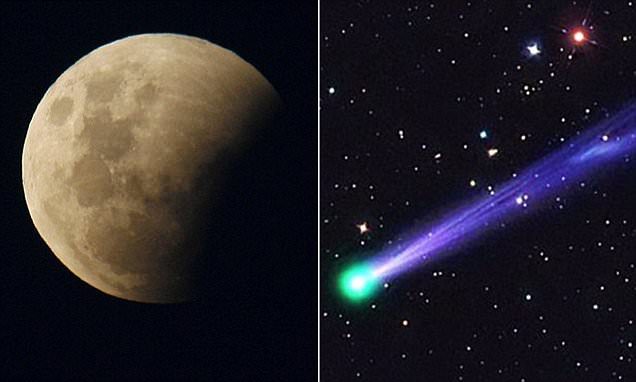
And just a few hours later, Comet 45P - also known as the New Year comet - will make its closest approach to the Earth.
The full event will be live streamed on Slooh, who will be filming the skies from the Canary Islands.
An eclipse of the moon occurs when the sun, Earth and moon line up, with Earth in the middle.
This alignment causes the Earth's shadow to fall on the moon, creating a lunar eclipse.
In a penumbral lunar eclipse, only the more diffuse outer shadow of Earth falls on the moon causing a more subtle shadow than a partial or total eclipse.
But provided the sky is free of clouds, the moon will turn a darker shade of silver during the eclipse.
In Europe, Africa and western Asia, the event will be seen as the moon is in the southern sky late at night, while for those in North, Central and South America, the best views will be from the east.
And for those in New York, the event will begin at 17:34 ET, and end at 21:53 ET. For viewers in the UK, the shadow will first cast over the moon at 22:34 GMT, and will end at 02:53 GMT.
To check if the lunar eclipse will be visible in your area, you can also look at the Time and Date site.
Along with the lunar eclipse, Comet 45P will make its closest approach to Earth.
In a blog on its website, Nasa said: 'Comet 45P, visible after sunset over the last two months - through both binoculars and telescopes - makes its closest approach to Earth on February 11, when it will be 0.08 Astronomical Units (7.4 million miles) from Earth.
'It'll be visible in the morning sky in the constellation Hercules.
'The comet then passes through the constellations Corona Borealis (the Northern Crown), Boötes (the Herdsman), Canes Venatici (Boötes' hunting dogs) and Ursa Major.
'Then on to Leo by the end of February.
'It moves swiftly - 9 degrees each day! It will return again in 2022.'
The comet makes its way back to the inner solar system roughly every 5 years, and has a bright bluish-green 'head.'
It can be difficult to spot with the naked eye, and you may need to use binoculars.



Caesar's Comet[2] (numerical designation C/-43 K1) – also known as Comet Caesar and the Great Comet of 44 BC – was perhaps the most famous comet of antiquity. Its seven-day visitation was interpreted by Romans as a sign of the deification of recently assassinated dictator, Julius Caesar (100–44 BC).[3] Caesar's Comet is one of only five comets known to have had a negative absolute magnitude and may have been the brightest daylight comet in recorded history.[4] It was not periodic and may have disintegrated.[citation needed] The parabolic orbital solution estimates that the comet would now be more than 800 AU from the Sun.[5]
Comets & Antiquity, Halley's Comet, ISON, Apophis, and More [Link]